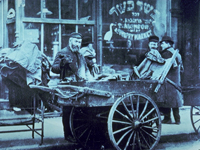The Wren Building
Louise Kale, director of the Historic Campus, outlines the history and restoration of the College of William and Mary's Wren Building, completed in 1700.
Louise Kale, director of the Historic Campus, outlines the history and restoration of the College of William and Mary's Wren Building, completed in 1700.
Revolutionary-era cannon are artifacts of war technology's evolution. Director of Historic Trades Jay Gaynor and Master Blacksmith Ken Schwarz describe the process of recreating a light infantry three-pounder.
Click here for part one of this podcast.
Revolutionary-era cannon are artifacts of war technology's evolution. Director of Historic Trades Jay Gaynor and Master Blacksmith Ken Schwarz describe the process of recreating a light infantry three-pounder.
Click here for part two of this podcast.
Relating the daily lives of America's ancestors is the product of research and performance. Performer Kat Getward shares the part that music plays in the Electronic Field Trip "Making History Live."
As important as the cannon is the vehicle to carry it: a two-wheeled cart that transports, supports, and stores the weapon and its accoutrements. Wheelwright John Boag has the task of construction.
The Old Stone House is a reconstruction of the 1699 Vechte-Cortelyou House, a Dutch farmhouse. The site interprets the role of the structure in the Revolutionary War and in shaping both Brooklyn, NY and the nation. During the August 22, 1776 Battle of Brooklyn, British forces seized the building, effectively cutting off American retreat. The Continental Army, outnumbered five to one, managed to regain control of the structure twice before finally losing ground. The bravery of the troops heartened George Washington and his men.
The site offers exhibits, tours, and 90-minute curriculum-based student programs. Pre- and post-visit materials are provided for all educational programs. Reservations are required for tours and student programs.
Patrick Henry, orator of the American Revolution and first governor of Virginia, made his home at Scotchtown from 1771 to 1778.
The site offers exhibits and tours.

A gateway and an archive of numerous articles on New York history, this site "focuses a particularly long lens on the early history of political and economic events, panics, riots and other related matters affecting or contributing to New York City's development and growth." Its main feature is the New York state and New York City directories. (The U.S. directory is currently unavailable.) The New York state directory offers more than 700 links and more than 60 articles organized under 21 topics that include the arts, cities and counties, ethnic groups, military, societies and associations, transportation, women and their professions, and worship.
The New York City directory offers more than 5,200 links and more than 700 articles organized under 58 topics that include architecture, the arts, business matters, city government, clubs and societies, crime and punishment, education, ethnic groups, 5th Avenue, Harlem, immigration, New York City panics, real estate, temperance and prohibition, and Wall Street. The visitor can search the entire site or each directory by keyword. This site is a good starting point for researching the history of New York. It should also be useful for literary scholars, writers, and historical societies.

An adjunct site to a PBS "Frontline" program exploring the claim that Thomas Jefferson fathered at least one and maybe all of the children of his slave, Sally Hemmings. This view is supported by DNA testing and believed valid by a consensus of historians and experts. The site presents ten essays ranging from 2,000 to 5,000 words in length by prominent historians and other scholars—including Joseph Ellis, Annette Gordon-Reed, Philip D. Morgan, Jack Rakove, and Gordon Woods—on the controversy, its historical background and significance, interracial sex in the antebellum Chesapeake region, Jefferson's legacy, and America's mixed-race heritage. The site also provides accounts by four Monticello slaves and the chief overseer; four video segments, from seven to nine minutes each; transcripts of interviews with Ellis, Gordon-Reed, Dr. Eugene Foster, who designed and carried out the testing, and Lucia Cinder Stanton, from the Thomas Jefferson Memorial Foundation; and links to a clearinghouse for information that argues against the claim.